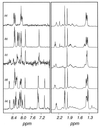Analysis of peptidoglycan structure from vegetative cells of Bacillus subtilis 168 and role of PBP 5 in peptidoglycan maturation
- PMID: 10383963
- PMCID: PMC93885
- DOI: 10.1128/JB.181.13.3956-3966.1999
Analysis of peptidoglycan structure from vegetative cells of Bacillus subtilis 168 and role of PBP 5 in peptidoglycan maturation
Abstract
The composition and fine structure of the vegetative cell wall peptidoglycan from Bacillus subtilis were determined by analysis of its constituent muropeptides. The structures of 39 muropeptides, representing 97% of the total peptidoglycan, were elucidated. About 99% analyzed muropeptides in B. subtilis vegetative cell peptidoglycan have the free carboxylic group of diaminopimelic acid amidated. Anhydromuropeptides and products missing a glucosamine at the nonreducing terminus account for 0.4 and 1.5%, respectively, of the total muropeptides. These two types of muropeptides are suggested to end glycan strands. An unexpected feature of B. subtilis muropeptides was the occurrence of a glycine residue in position 5 of the peptide side chain on monomers or oligomers, which account for 2.7% of the total muropeptides. This amount is, however, dependent on the composition of the growth media. Potential attachment sites for anionic polymers to peptidoglycan occur on dominant muropeptides and account for 2.1% of the total. B. subtilis peptidoglycan is incompletely digested by lysozyme due to de-N-acetylation of glucosamine, which occurs on 17.3% of muropeptides. The cross-linking index of the polymer changes with the growth phase. It is highest in late stationary phase, with a value of 33.2 or 44% per muramic acid residue, as determined by reverse-phase high-pressure liquid chromatography or gel filtration, respectively. Analysis of the muropeptide composition of a dacA (PBP 5) mutant shows a dramatic decrease of muropeptides with tripeptide side chains and an increase or appearance of muropeptides with pentapeptide side chains in monomers or oligomers. The total muropeptides with pentapeptide side chains accounts for almost 82% in the dacA mutant. This major low-molecular-weight PBP (DD-carboxypeptidase) is suggested to play a role in peptidoglycan maturation.
Figures



References
-
- Archibald A R, Hancock I C, Harwood C R. Cell wall structure, synthesis, and turnover. In: Hoch J A, Losick R, editors. Bacillus subtilis and other gram-positive bacteria, biochemistry, physiology, and molecular genetics. Washington, D.C: American Society for Microbiology; 1993. pp. 381–410.
-
- Atrih A, Bacher G, Körner R, Allmaier G, Foster S J. Structural analysis of Bacillus megaterium KM spores peptidoglycan and its dynamics during germination. Microbiology. 1999;145:1033–1041. - PubMed
-
- Blackman S A, Smith T J, Foster S J. The role of autolysins during vegetative growth of Bacillus subtilis 168. Microbiology. 1998;145:57–65. - PubMed
Publication types
MeSH terms
Substances
LinkOut - more resources
Full Text Sources
Other Literature Sources
Molecular Biology Databases
Research Materials
Miscellaneous

